

The Porsche 911 2.7 1974-1977
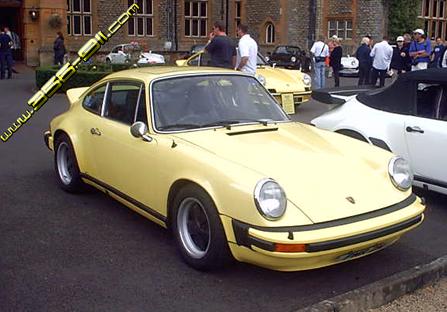
The entire 911 line was changed in 1974, with the base 911 having a new 2.7L flat-6 which was derived from the Carrera RS engine with the soon to be infamous magnesium case. The 1974 Carrera was a good performer until the introduction of the emmisions equipment in 1975, which boosted the engine bay temperature and strangled the breathing. The consequences among other things were; head studs that pulled out of the crank case (due to thermal expansion of the cylinders) and destroyed valve trains. All of this resulted in an average engine life of about 50,000 miles. External changes from 1973 were the large heavy duty impact bumpers and other safety reinforcements like reinforced doors, which all added to the cars weight. 1977 saw the first year of fully galvanized sheet metal.
911 Year : 1974 - 77
Body : Coupé, Targa
Cubic capacity : 2,687 cc
Power : 150 hp
Production : 17,260
911 S Year : 1974 - 1977
Body : Coupé, Targa
Cubic capacity : 2,687 cc
Power : 175 hp, 165 hp (USA), 160 hp (California)
Production : 17,124
911 Carrera Year : 1974 - 1975
Body : Coupé, Targa
Cubic capacity : 2,687 cc
Power : 210 hp, 175 hp (USA), 165 hp (USA, 1975)
Production : 3,353
The 911 Carrera 3.0 1976-1977
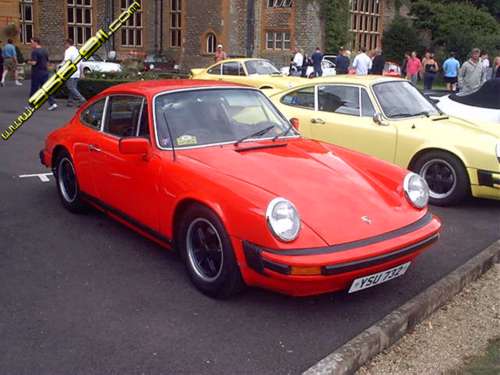
The Carrera 3.0 had 200 horsepower coming from a 2,997cc engine. This car tends to be a sought after car in North America and was produced from 1976-77. In 1978, the 911 Carrera 3.0 was replaced by the 3.0 SC.
911 Carrera 3.0 Year : 1976 - 1977
Body : Coupé, Targa
Cubic capacity : 2,994 cc
Power : 200 hp
Production : 3,691
The 911 SC 1978-1983
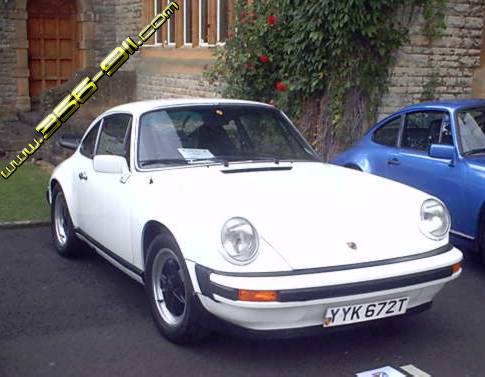
The 911 SC was introduced in 1978 for all markets. It held a 3.0 litre engine and produced 180bhp. It remained pretty much the same over its lifespan apart from engine head modifications in 1980 to increase the output to 204bhp. In 1984 the 911SC Cabriolet was introduced, and was the first convertible Porsche since the 356. This became an extremely popular car, and was heralded as the fastest convertable in the world. They were sold out more than a year in advance. The Cabrio led Porsche into 1984, where the 911 Carrera replaced the SC.
911 SC Year : 1978 - 1983
Body : Coupé, Targa, Cabriolet (1983)
Cubic capacity : 2,994 cc
Power : 180 hp (1978), 188 hp (1980), 204 hp (1981)
Production : 57, 972
The 911 Carrera 1984-1989
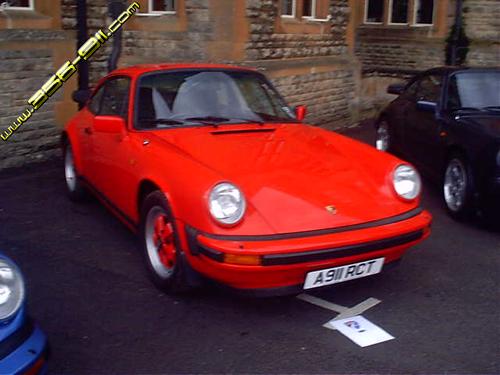
In 1984 the 911 was 20 years old. The SC 3.0 was replaced by the new Carrera with a 3.2 engine, producing 202 hp. This car was the first to have DME fuel and ignition. The bodywork, suspension, and most of the interior were taken from the SC, the brakes were upgraded with a bigger booster and larger rotors. The heating system was upgraded, too, with two extra blowers. An option for 1984 included the Turbo look body, and was equiped with the same chassis, brakes and wheels. But due to to less aerodynamic body it wasnt as fast as the standard Carrera. In 1985, this option could be used on Coupes, Targas, or Cabriolets, with the option of whaletail and front spoilers.
In 1986 the Cabriolet recieved an electric top. Boge gas shocks were standard equipment. The sway bars and rear torsion bars were beefed up. A completely new and now sought after transmission was applied in 1987, the G 50, replacing the notchy 915. The clutch was enlarged to cope with the larger engine. Hydraulic master and slave cylinders lightened the clutch. Power was at 217bhp. In 1988 A support brace was added between the transmission and the left heat exchanger to reduce the noise of the G 50 transmission. Also in 1988, a special edition 911 Carrera Clubsport was offered, 340 were produced.The clubsport was presented as a 'light-weight' model. They were stripped to the bare essentials, electric windows, electric seats, and radio were all deleted. The weight saving however wasn't spectacular 50 kg, it also had a modified ECU.
Towards the end of the 3.2 Carrera's lifespan Porsche introduced a new Speedster. Style elements were taken from the 356 Speedster, the Carrera 3.2 Speedster was based on the cabrio, but had a lower and flatter windscreen and a simpler manual top that folded beneath a fiberglass cover. The turbo-look option was available for the Speedster and it was so popular that only 171 of the 2065 produced were delivered without it. The speedster was kept a very basic car, to the same tradition of the original 356 speedster. It didn't have electric windows, seats, and other electrical toys. The standard speedster was said to be 70 kg lighter than the standard car. When the car was ordered in the turbo-look the weight difference was reduced to zero
1989 was the last year for the 911 Carrera.
911 Carrera Year : 1984 - 1989
Body : Coupé, Targa, Cabriolet, Speedster with Turbo Look option
Cubic capacity : 3,164 cc
Power : 231 hp, 207 hp (USA), 217 hp (USA, 1987)
Production : 76,131 including 2065 Speedster and 610 Club Sport
The Porsche 911 Carrera 2/4 1990-1994
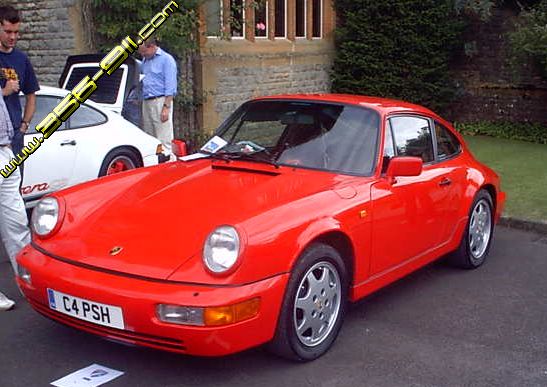
The 911/964 Carrera 4 of 1989 was claimed to be 87% new, it had new front and rear suspensions, modern aerodynamics, an advanced electronic 4-wheel drive system and a heavily revised engine. The monocoque chassis of the 3.2 Carrera was basically unaltered, so was the general body shape that characterised 911 for a quarter of a century. The bumpers were now smooth, body-integrated and body-coloured. Which not only smoothed out the new lines, they also achieved a remarkable drag coefficient of 0.32 while generating virtually no lift at high speed. Apart from bumpers, the flat undertrays which sealed front suspension, engine and transmission tunnel also played an important role to reduce drag and lift, so did the automatically raised rear spoiler which replaced a fixed wing. The spoiler normally acted as ventilation for the engine and recessed smoothly on the engine lid. It raised at above 50 mph and dropped down at under 6 mph.
The flat-six engine received so much modifications that it was given a new name, M64 series. Its major mission was to comply with stricter emission regulations, cope with the considerable weight increase of the 964 without compromising performance. Moreover, it was designed to be a "world engine" - suitable for all markets without any modifications. To achieve 250 hp and 228 lbft output (up from Carrera 3.2’s 231 hp and 210 lbft) even in the presence of catalytic converter, it was bored and stroked to 3.6 litres and employed a very high compression ratio of 11.3:1 which was made possible by twin-spark per cylinder and knock sensor. Advancer Motronic program worked in associate with ignition and sequential fuel injection. A 2-stage resonance intake manifold was introduced to improve mid to high speed power. That enabled the Carrera 4 to sprint to 60 mph in 5.2 sec, slightly quicker than its predecessor. That was very respectable, considering the car weighed an astonishing 250 kg more. It topped 161 mph, which actually matched the contemporary 911 Turbo 3.3, thanks to superior aerodynamics. For the first time, the 911 received a proper MacPherson strut suspension with concentric coil spring instead of torsion bar. As earlier we have mentioned, the original 911 chose torsion bar in order to give more luggage room at the front. However, as Carrera 4 had the 4WD system already engaged a lot of space, there was no reason to maintain the torsion bar setup. At the rear, a revision of geometry to the semi-trailing arms, plus addition of rubber bushing to pivot joints, enabled a passive rear-wheel steer (inspired by 928’s Weissach axle) to counter the oversteering. The new trailing arm was also made in cast aluminium instead of iron. However, the biggest technology breakthrough must be the intelligent 4-wheel drive, which was simplified from 959. It normally transferred 69% torque to the rear axle, but in case of slide, the electronic control could send more to the wheels which had most traction. Active rear LSD also keep oversteer tightly in check.
The engine can be coupled with two types of transmissions; the five-speed manual, or 4 speed Tiptronic. The Tiptronic transmission is an automatic, with the usual PRND321 selections, but it can be used as a manual shifter, too. While the car is in the "Drive" position, you can push the stick horizontally to the right into a second slot, which is parallel to the "regular" slot. The shifter sits in the slot, with the ability to be moved "up" one position, or "down" one position. When you "tip" the stick forward, the car will upshift, and when you "tip" it back towards you, it'll downshift. So, in essence, you can plant your foot on the gas, and when you're ready to shift, tip it forward. Without having a clutch to operate, you can treat it like an automatic, but shift when you want! If, for some reason, you don't shift it at redline, the computer will do it for you. Also, if you try to downshift it at a speed where the engine will redline in the lower gear, the computer will again interrupt.
911 Carrera 4 (type 964) Year : 1989 - 1993
Body : Coupé, Targa (1990), Cabriolet (1990), Turbo Look (special anniversary edition)
Cubic capacity : 3,600 cc
Power : 260 hp
Production : 15,121 and 911 for the special edition model
911 Carrera 2 (type 964) Year : 1990 - 1993
Body : Coupé, Targa, Cabriolet, Cabriolet Turbo Look, Speedster Cubic
capacity : 3,600 cc
Power : 250 hp
Production : 24,501 and 742 Cabriolet Turbo Look, 925 Speedster
Porsche 993 Carrera 2 & 4
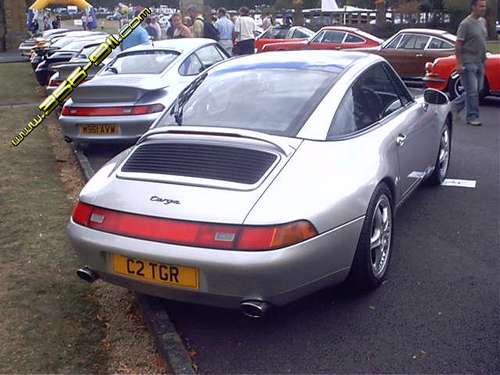
The most obvious change to the 911 for the introduction of the 993 was the overall shape, the 911's headlamps were tilted and smoothed with the body similar to the 959. The front bonnet was raised to enlarge luggage space, although that deteriorated aerodynamic drag by one point to 0.33. Both the front and rear wheel arches were widened to accommodate the increased tracks, but unlike any previous Turbo or Turbo-Look, the fenders integrated smoothly with the body. The body shell was nearly all-new, although the roof rails and roof panel remained unaltered. Chassis strength was increased without any gain in weight. It is regarded by many to this day as the best looking of the modern 911's. Minimal changes were made to the M64 engine because its performance was still good, especially with an additional 22bhp produced by lighter pistons, lighter con-rods and larger catalyst / siliencer.. Torque was also improved from 228 lbft to 243 lbft. Magnesium and plastic were extensively used in various parts thus making the engine 6 kg lighter than 964’s. The performance difference between new and old Carrera 4 was improved thanks to a simpler viscous-coupling 4WD system which lost 50% of its weight and generated less frictional loss.
In 1996, Varioram variable intake system, first seen in the 993 RS of the previous year, was added to all 993 engines. Based on the existing 2-stage resonance intake system, it added a 2-stage long and short manifold system to create a 3-stage device to boost torque across the whole rev range. In addition to larger valves, it output 285 hp and 251 lbft. At mid-range, there was as much as 29 lbft extra torque available.
The success of 993 was partially due to the failure 989 sports saloon which was cancelled at the last stage of developmentt. Porsche transferred the car’s advanced multi-link rear suspension to the new 911. That was a double-wishbones-based, 5-link design with aluminium links and mounted on an aluminium subframe which attached to the body via rubber bushings. The result was vast improvement of wheel control, ride comfort and quietness compare with the semi-trailing arm used by all previous 911s. It also enabled passive rear-wheel steering. The tracks front and rear were widened by 25 and 70 mm respectively, accompanied with quicker steering ratio.
The 1995 Carrera RS was even better. Employing a 300 hp 3.8-litre version of M64, with kerb weight reduced to 1270 kg by usual measures, further enhanced with sportier suspensions and brakes etc., it was praised as the best handling 911 after the original RS 2.7
911 Carrera (type 993) Year : 1993 - 1998
Body : Coupé, Cabriolet, Targa (1996), Coupe S (1997)
Cubic capacity : 3,600 cc
Power : 272 hp, 285 hp (1996), 300 hp (3.8 RS engine, 1997)
Production : 46,919
911 Carrera 4 (type 993) Year : 1993 - 1998
Body : Coupé, Coupe 4S (1996)
Cubic capacity : 3,600 cc
Power : 272 hp, 285 hp (1996), 300 hp (3.8 RS engine, 1997)
Production : 14,114
Porsche 996 Carrera 2 & 4
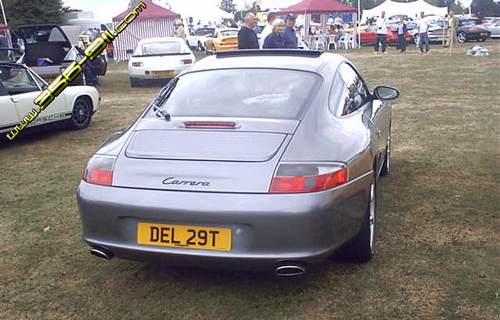
911 Carrera (type 996) Year : 1999 -
Body : Coupé, Cabriolet
Cubic capacity : 3,387 cc
Power : 300 hp
911 Carrera 4 (type 996) Year : 1999 -
Body : Coupé, Cabriolet
Cubic capacity : 3,387 cc
Power : 300 hp